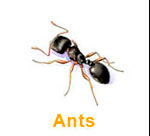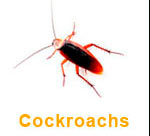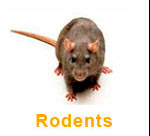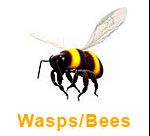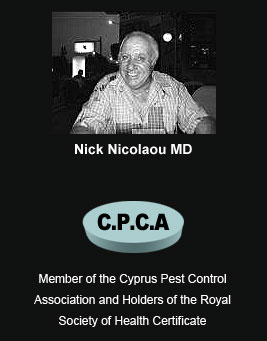Cockroaches
Cockroaches are among the most undesirable insect intruders in the home. They are associated with filth and unsanitary conditions, although they occasionally invade the best-kept homes.Though known to carry various disease organisms, cockroaches have not been associated with any major disease outbreaks in this country. The insects also produce a secretion that has a repulsive odor and can affect the flavor of food. Cockroaches can cause allergic reactions when sensitive people come into contact with contaminated food or house dust.
Biology
Three cockroach life forms can be found in an infested area. The egg case is the size and shape of a bean and contains 10 to 20 cockroach eggs. As the eggs hatch, young cockroaches, or nymphs, emerge. Similar in shape and color to the adults, they are smaller and wingless. Their habitats and food preferences are the same as those of adults.Cockroaches are active at night, so daytime observation is a good sign of a heavy infestation. They prefer protected areas, such as cracks and crevices, to rest and hide. Although cockroaches prefer starchy foods and meats, they will eat anything of plant or animal origin.
Common Species
The German cockroach is the most troublesome of all cockroaches. One of the smaller species, 1.5 cm when full grown, it is light brown with a pair of parallel brown bars between the head and the front of the wings. This species usually is associated with buildings where food is prepared or stored. It commonly migrates from infested areas into nearby dwellings or may be carried in on food containers. Favorite home habitats are warm, moist areas, such as kitchen sinks and appliances and bathroom sinks.The American cockroach is the largest pest species found, ?up to 5cm long. ?It is mahogany-colored with a yellow margin around the head and around the shield behind the head. Although occasionally found in homes, the American cockroach more commonly is found in warm, moist areas like sewers and manholes.
Snakes
Snake control. Normally, snake repellent is used for the control of snakes in Cyprus or alternatively live snake traps can be used if preferred.
Rodents
Rats: Instincts: Rats are instinctively wary of rat control measures such as traps and bait, and colonize in attics, burrows, under concrete and porches, in wall voids and other hard to reach places.Disease: Rats can harbor and transmit a number of serious diseases. They can also introduce disease-carrying parasites such as fleas, lice and ticks into your home.
Mice: Access: They invade your home seeking food, water and warmth. Without mouse control intervention, one pair of mice may produce 200 offspring in four months.Contamination: Each mouse can contaminate much more food than it eats.
Pigeons
Often referred to as ?rats with wings?, feral pigeons have become just as much of a problem in towns and cities as their furry, four-legged counterparts.?An undisputed and particularly visual pigeon problem however is mess. Combined pigeon deposits can weigh up to several tons.?Fresh droppings, whilst unpleasant, pose no risk to health. It is dried droppings that can potentially spread infection. ?Spores from the droppings can be inhaled as dust and carried on the wind. It can cause a flu like illness in healthy people, but poses more serious problems to those with low immunity.
Termites
Termites don’t live on their own. They infest your house in colonies, organized similarly to a bee hive or an ant’s nest. That affects the way you have to try to deal with them, because it’s not just a matter of killing some of them. You have to kill off the colony for the infestation to end.?Termites can seriously damage the structure of a house or building. ?Termite droppings which resemble small mounds of black pepper, can be a warning sign for activity. Do not clean up until after your inspector has identified it.
Ants
Ants are one of the most common pests in and around homes. They are social insects and are divided up into three castes: workers, males, and queens.?Ants have a wide variety of nesting habits and food preferences. Some ants build nests in soil, producing characteristic mounds while others nest in homes behind moldings, baseboards, countertops, and similar places. Still other ants nest in decaying or moisture damaged wood. Ants feed on different types of food, including starches, meats, fats, and sweets.
Many ants also feed on honeydew, a sweet liquid produced by aphids and scale insects. Knowledge of ant food and nesting preferences is very important in controlling ant colonies.Damage from ants varies. Most are primarily a nuisance and cause little damage. Some, such as Pharaoh ants, may infest food. Others, like carpenter ants, can weaken wood in structures. Generally, there are no disease problems associated with ants.
Bedbugs
Bedbugs have feasted on sleeping humans for thousands of years. After World War II, they were eradicated from most developed nations with the use of DDT. This pesticide has since been banned because it’s so toxic to the environment.Spurred perhaps by increases in international travel, bedbugs are becoming a problem once again.
The risk of encountering bedbugs increases if you spend time in places with high turnovers of night-time guests ? such as hotels, hospitals or homeless shelters.Bedbugs are reddish brown, oval and flat, about the size of an apple seed. During the day, they hide in the cracks and crevices of beds, box springs, headboards and bed frames. It’s a daunting task to eliminate bedbugs from your home. Professional help is recommended.
Fleas
Fleas pass through a complete life cycle: egg, larva, pupa, and adult. The clear-to-white eggs can be seen without magnification. Eggs are laid on pets or other warm blooded hosts but may be found wherever they fall off a flea infested pet. It takes from one to 12 days for the eggs to hatch. ? ? ? ?Fleas that are living on your cat or dog lay eggs. The eggs drop off your pet and land on your carpet or floor. ?Rats and mice can also be sources of fleas or causes of continuing infestation. However, fleas can survive in homes where there are only humans.
It is a fact that some humans are resistant to or immune to flea bites. That is, they can live with the fleas and not be aware that pests are present. But most people are very sensitive to flea bites. Flea bites are most likely to be found on the legs of people in flea infested areas, but with proper flea prevention, you can spare yourself the annoyance and difficulty in dealing with a nasty flea infestation.
Wasps / Bees
Wasps and bees are beneficial insects, although they are generally considered to be pests because of their ability to sting. Wasps, in particular, can become a problem in autumn when they may disrupt many outdoor activities. People often mistakenly call all stinging insects “bees”. While both social wasps and bees live in colonies ruled by queens and maintained by workers, they look and behave differently. It is important to distinguish between these insects because different methods may be necessary to control them if they become a nuisance.
Food Preferences
Wasps are predators, feeding insects and other arthropods to their young, which develop in the nest. They are beneficial because they prey on many insects, including caterpillars, flies, crickets, and other pests. During late summer and fall, as queens stop laying eggs and their nests decline, wasps change their food gathering priorities and are more interested in collecting sweets and other carbohydrates. Some wasps may become aggressive scavengers around human food and may be common around outdoor activities where food or drinks are served.
Wasp & Bee Stings
Wasps and bees sting to defend themselves or their colony. Stinging involves the injection of a protein venom that causes pain and other reactions.?Wasps and bumble bees can sting more than once because they are able to pull out their stinger without injury to themselves. If you are stung by a wasp or bumble bee, the stinger is not left in your skin.?Honey bees have barbs on their stinger which remain hooked in the skin. The stinger, which is connected to the digestive system of the bee, is torn out of the abdomen as the bee attempts to fly away. As a result, the bee soon dies. If you are stung by a honey bee, scratch out the stinger (with its attached venom gland) with your fingernail as soon as possible. Do not try to pull out the stinger between two fingers. Doing so only forces more venom into your skin, causing greater irritation.


